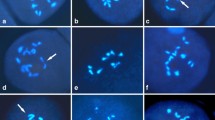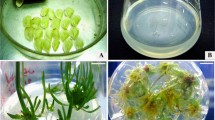Summary
Eight different genotypes of the F1 hybrids between Oriental × Asiatic lily (Lilium) hybrids (2n = 2x = 24) were treated with nitrous oxide (N2O) gas under pressure for 24 and 48 hours. At the time of treatment, all plants possessed early meiotic stages in the anthers of the oldest flower buds. The mature flowers from treated plants were monitored for fertility through pollen germination in vitro as well as by using them in crosses with diploid Asiatic hybrids (2n = 2x = 24) both as male and female parents. In five out of the eight genotypes of OA hybrids there was evidence for the production of 2n pollen which germinated in vitro from either one or both treatments. The 2n pollen from three genotypes was successfully used in crosses. In two cases, the treated plants were successfully used as female parents which indicated the formation of 2n (or 2x) egg cells. From an analysis of 41 sexual polyploid progenies obtained from N2O treated plants it was shown that they were all euploids consisting of 34 triploids (2n = 3x = 36) and seven tetraploids (2n = 4x = 48). A detailed cytological analysis of 12 progeny plants through genomic in situ hybridization (GISH) proved that N2O had induced first division restitution gametes in most cases and in two cases they produced gametes through indeterminate meiotic restitution. There was evidence for intergenomic recombination in three cases.
Similar content being viewed by others
References
Barba-Gonzalez, R., A.C. Lokker, K-B. Lim, M.S. Ramanna & J.M. Van Tuyl, 2004. Use of 2n gametes for the production of sexual polyploids from sterile Oriental × Asiatic hybrids of lilies (Lilium). Theor Appl Genet 109: 1125–1132.
Berdahi, J.D. & R.E. Barker, 1991. Characterization of autotetraploid Russian wildrye produced with nitrous oxide. Crop Sci 31: 1153–1155.
Bretagnolle, F. & J.D. Thompson, 1995. Gametes with somatic chromosome number: Mechanisms of their formation and role in the evolution of autopolyploid plants. New Phytol 129: 1–22.
De Boer-De Jeu, M.J., 1978. Megasporogenesis. Mededelingen Landbowhogeschool Wageningen. The Netherlands. 78(16) 128 pp.
Dvorak, J., B.L. Harvey & B.E. Coulman, 1973. The use of nitrous oxide for producing eupolyploids and aneuploids in wheat and barley. Can J Genet Cytol 15: 205–214.
Giri, N., N.L. Taylor & G.B. Collins, 1983. Chromosome stability and fertility of a nitrous oxide-derived tetraploid population of red clover. Crop Sci 23: 45–47.
Jensen, C.J., 1974. Chromosome doubling techniques in haploids. In: Kasha K.J. (Ed) Haploids in higher plants. Proc of 1st Intern Symp. Guelph. Ontario Canada.
Kamstra SA, M.S. Ramanna, M/J De Jeu, A.G.J. Kuipers & E. Jacobsen, 1999. Homoeologous chromosome pairing in the distant hybrid Alstroemeria aurea × A. inodora and the genome composition of its backcross derivatives determined by fluorescence in situ hybridization with species-specific probes. Heredity 82: 69–78.
Karlov, G.I., L.I. Khrustaleva, K-B. Lim & J.M. Van Tuyl, 1999. Homoeologous recombination in 2n-gamete producing interspecific hybrids of Lilium (Liliaceae) studied by genomic in situ hybridization (GISH). Genome 42: 681–686.
Lim, K-B., M.S. Ramanna, J.H. De Jong, E. Jacobsen & J.M. Van Tuyl, 2001. Indeterminate restitution (IMR): A novel type of meiotic nuclear restitution mechanism detected in interspecific lily hybrids by GISH. Theor Appl Genet 103: 219–230.
Lim, K-B., M.S. Ramanna & J.M. Van Tuyl, 2003. Homoeologous recombination in interspecific hybrids of Lilium. Korean J Breed 35: 8–12.
Lord, E. & K. Gould, 1989. Kinematic analysis of lily flower organs. In: E. Lord & G. Bernier (Eds.) Plant Reproduction: From Floral Induction to Pollination. Proc. 12th Ann. Symp Plant Physiol, Univ Calif Riverside, Amer Soc Plant Physiol Rockville MD, pp 82–94.
Mariani, A. & S. Tavoletti, 1992. Gametes with somatic chromosome number in the evolution and breeding of polyploid polysomic species. Proc Workshop, Perugia, Tipolithographia Porziuncola-Assisi (PG) Italy, pp. 1–103.
Montezuma-De-Carvalho, J., 1973. The effect of N2O on meiosis. Boletim da Sociedade Broteriana 47: 5–16.
Nygren, A., 1955. Polyploids in Melandrium produced by nitrous oxide. Hereditas 11: 287–290.
Östergren, G., 1954. Polyploids and aneuploids of Crepis capilaris produced by treatment with nitrous oxide. Genetica 27: 54–64.
Östergren, G., 1957. Production of polyploids and aneuploids of Phalaris by means of nitrous oxide. Hereditas 43: 512–516.
Ramanna, M.S. & E. Jacobsen, 2003. Relevance of sexual polyploidization for crop improvement – A review. Euphytica 133: 3–18.
Ramanna, M.S., A.G.J. Kuipers & E. Jacobsen, 2003. Occurrence of numerically unreduced (2n) gametes in Alstroemeria interspecific hybrids and their significance for sexual polyploidisation. Euphytica 133:95–106.
Tsunewaki, K., 1962. Production of polyploid wheat by nitrous oxide, II. N2O treatment during fertilization with reference to culture media. Seiken Siho 14: 12–20.
Tylor, J.H. & R.D. McCaster, 1954. Autpradiographic and microphotometric studies of desoxyribose nucleic acid during microsporogenesis in Lilium lingiflorum. Chromosoma 6: 489.
Van Tuyl, J.M., M.P. Van Diën, M.G.M. Van Creij, T.C.M. Van Kleinwee, J. Franken & R.J. Bino, 1991. Application of in vitro pollination, ovary culture, ovule culture and embryo rescue for overcoming incongruity barriers in interspecific Lilium crosses. Plant Sci 74: 115–126.
Walters, M.S., 1976. Variation in preleptotene chromosome contraction among three cultivars of Lilium longiflorum. Chromosoma 57: 51–80.
Walters, M.S., 1980. Premeiosis and meiosis in Lilium “Enchantment”. Chromosoma 80: 119–146.
Zeilinga, A.E. & H.P. Schouten, 1966. Tetraploide tulpen, een mogelijk-heid voor de verbetering van het tulpensortiment. Instituut voor de Veredeling van Tuinbouwgewassen, Institute of Horticultural Plant Breeding. Mededeling 256: 17–23.
Author information
Authors and Affiliations
Corresponding author
Rights and permissions
About this article
Cite this article
Barba-Gonzalez, R., Miller, C.T., Ramanna, M.S. et al. Nitrous oxide (N2O) induces 2n gametes in sterile F1 hybrids between Oriental × Asiatic lily (Lilium) hybrids and leads to intergenomic recombination. Euphytica 148, 303–309 (2006). https://doi.org/10.1007/s10681-005-9032-0
Received:
Accepted:
Published:
Issue Date:
DOI: https://doi.org/10.1007/s10681-005-9032-0




